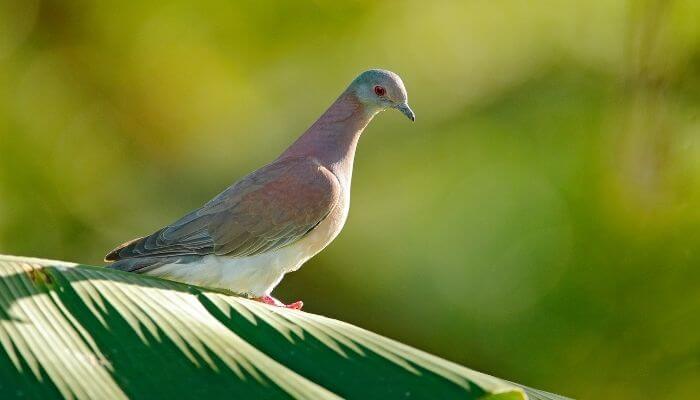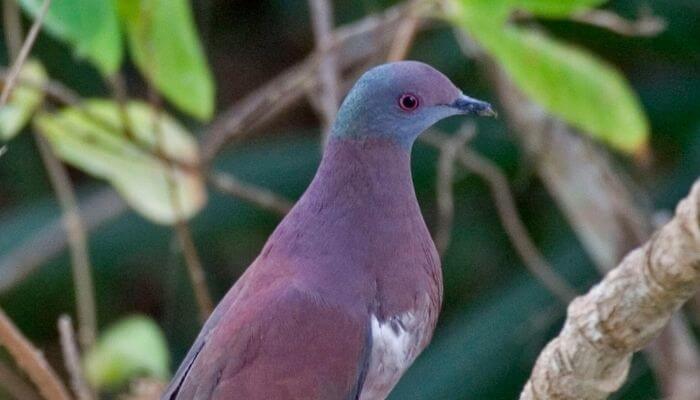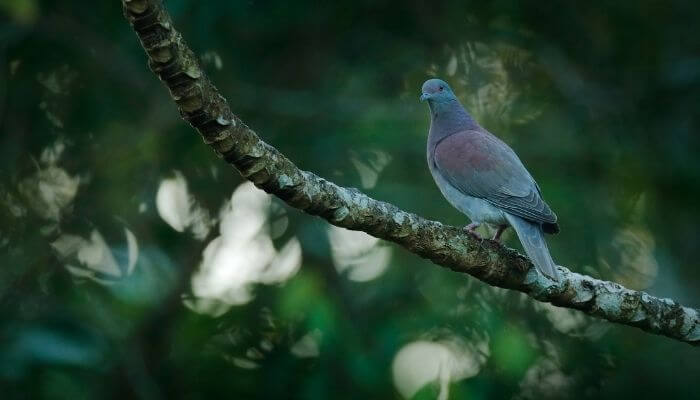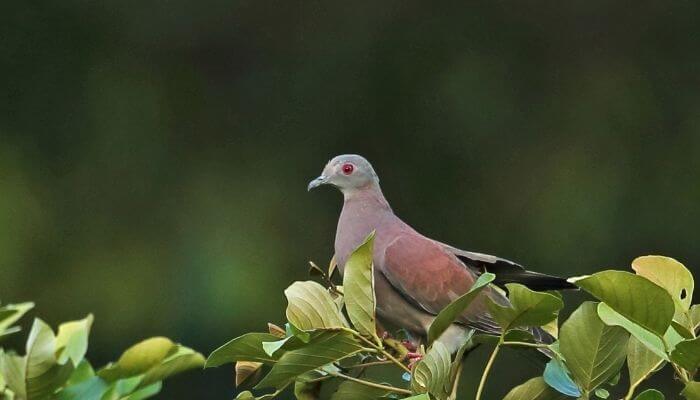Pale-vented pigeons are large, arboreal birds that live in the wild on tall trees.

Although you can also see them in urban areas, parks, and city roads.
They usually perch on tall structures, scouring for food.
You might even see them casually strolling around looking for leftovers.
These shy birds are a taxonomic species within the genus Patagioenas called Patagioenas cayennensis.
It’s Greek, Patageö means noise, and Oinas means dove.
Origins of the Pale-Vented Pigeon
The Pale-vented pigeon is a resident of a large section of the tropical Americas.
Though, there are areas where they’re more prevalent, including southern Mexico down to Bolivia and northern parts of Argentina.
They’re also common in the Republic of Tobago and Trinidad, located off the coast of Venezuela. In addition, stray vagrants could be spotted in Uruguay and Brazil.

However, it has never been recorded to breed or localize there.
These members of the Columbidae family were formerly believed to be part of the Columba species.
This group has 35 known species of medium to large stout-bodied pigeons, including Hill pigeons and Snow pigeons, just to name a couple.
Unfortunately, two of these groups are now extinct.
The Bonin wood pigeon went extinct in 1890, whereas the Ryukyu wood pigeon became extinct in the 1930s.
Nevertheless, experts finally decided they made a better fit in the group known as a tinamous clade.
It’s part of the older New World genus, the Patagioenas, which is mainly made up of ground-dwelling birds.
Habitat Of The Pale-Vented Pigeon
The Pale-vented pigeon habitats extend through the warm-temperate and tropical Americas.
They inhabit savannas, forest edges, and riverbanks.

You can also find them in open areas where they can easily find food and safely set up their nests on lower branches.
Their nests are small and built with twigs and dried leaves.
The IUCN classifies Pale-vented pigeons as ‘least concern,’ which means they’re neither rare nor threatened.
Pale-Vented Pigeon Appearance
Pale-vented pigeons are recognized by the purple plumage covering their head, breast, and upper part.

Yet, it’s their white throat and copper nape that make them stand out.
The pigeon has pale gray plumage on its vent, hence the name.
| Wingspan | Length | Weight | Coloring | |
|---|---|---|---|---|
| Pale-Vented Pigeon | N/A | 30 – 32 cm | 230 – 250 g | Dull purple with copper glossed nape and whitish throat |
| Average Feral Pigeon | 64 – 72 cm | 32 – 37 cm | 300 – 500 g | Bluish gray with some black |
The plumage is a little darker shade of gray on the back and tail. The bill is black and their legs and eyes are a matching red color.
Adult males and females have similar colors, but the female is duller.
In contrast, juveniles are covered in a dull grayish brown.
Similar Species
The Pale-vented pigeons are similar to the Scaled Pigeon.
Both are considered large pigeon species that are known to fly in open areas away from forests.

They also have the same flight pattern and display but are slightly different in appearance.
In addition, Pale-vented pigeons are similar to Plumbeous and Ruddy Pigeons.
However, Ruddy Pigeons and Plumbeous Pigeons prefer to fly inside forests instead of river edges and they’re typically darker with a more consistent flying pattern.
Habits
In general, Pale-vented pigeons are diurnal.
They have poor night vision, so as a result, they prefer to be more active during the daytime.
They perch on high trees, posts, and billboard signs where they can have a clear and visible view of their surroundings.
These pigeons are solitary birds, and you’ll often spot them alone.
Although, they might congregate in flocks at drinking areas and on fruiting trees.

Pale-vented pigeons have the same flight characteristics as most pigeons; fast, high, and direct.
They’re characterized by their steady wing beats and infrequent sharp strokes.
Their unique flight breeding display is flying in semi-circles before gliding back to the perch.
These pigeons are herbivores; they feed on plants, seeds, and fruit.
This classifies them as both frugivores and granivores.
Pale-vented pigeon calls are similar to other Patagioenas, mainly Red-billed and plain pigeons. It starts with an initial short kuk followed by a row of soft kuk kuk croo-ooos.
Pale-Vented Pigeons as Pets
Like many pigeon breeds, a Pale-vented pigeon makes a good pet.
It’s easy to train, tame, and breed a Pale-vented pigeon because they’re intelligent and calm creatures. Plus, they’re colorful and beautiful to look at.
They have an average life span of about six years, which is a lot in bird years.
Some breeds make better pets than others because they have been more domesticated through the years.
Some of these breeds include:
- King pigeon
- Tumbler pigeon
- Fantail pigeons
- Barb pigeons
- Homing pigeons
- Archangel Pigeon
- Cumulet Pigeon
- Dragoon Pigeon
- Florentine pigeon
- Carneau pigeon
Summary
Pale-vented pigeons belong to the genus Patagioenas, a common pigeon in tropical America.
These pigeons can be spotted out in their wild habitat or in cities where they sometimes settle.
They’re a common member of the Columbidae family with no distinctive behavior.
Their colorful appearance is enough to impress!
